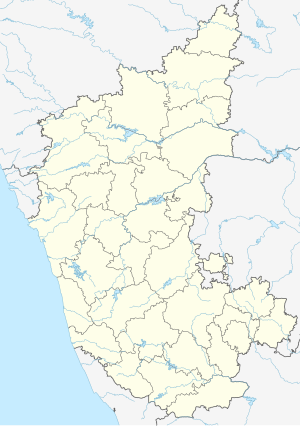Battle of Bidar
Script error: No such module "Draft topics".
Script error: No such module "AfC topic".
| Battle of Bidar | |||||||
|---|---|---|---|---|---|---|---|
| Part of Battles involving the Maratha Empire | |||||||
| |||||||
| Belligerents | |||||||
|
|
| ||||||
| Commanders and leaders | |||||||
|
|
| ||||||
| Strength | |||||||
| 40000[4] | unknown | ||||||
| Casualties and losses | |||||||
| unknown | heavy | ||||||
The Battle of Bidar that took place in the 18th century. After the death of the Peshwa Madhavrao in 1772, his brother and successor, Narayanrao, was assassinated on August 30, 1773, triggering a civil war among the Marathas.[2][5][6]
Background[edit]
Raghunathrao, a member of the Maratha royal family marched against the Nizam. Raghunathrao assembled a large army of Maratha soldiers along with contingents from other Maratha confederates, with the objective of extending Maratha influence in the Deccan region.[1][7]
Battle[edit]
In 1773, Raghunathrao launched a military campaign to capture Bidar, an important fortification in the Nizam's territory. The Nizam, with French military support, tried to defend Bidar, but was ultimately defeated by the Maratha army after a month-long battle.[5][2]Despite this assistance, the Nizam's forces were eventually defeated by the Maratha army.The Nizam's forces were supported by a contingent of French-trained troops during the battle for Bidar. The French had a long-standing alliance with the Nizam and had provided him with military assistance in the past.The French troops played a crucial role in defending Bidar, as they were well-trained and armed with modern weapons. They were also assisted by a French officer, Marquis de Bussy-Castelnau who was in charge of training the Nizam's troops. The Marathas' superior numbers and tactics played a significant role in their victory, but the presence of the French-trained troops and their weapons certainly made the battle more challenging for the Marathas.[5][2][8][9]
Aftermath[edit]
For the Marathas, the capture of Bidar gave them a strategic advantage in the region. They now had a strong foothold in the Nizam's territory and could exert greater control over the Deccan. This victory also boosted the Marathas' reputation and further enhanced their military prowess.[1][10]
On the other hand, the Nizam suffered a major setback. The loss of Bidar weakened his position and diminished his authority in the region. The defeat also strained the Nizam's relationship with the French, as their support was unable to prevent the Maratha victory.[1] The Battle of Bidar was a significant win for the Maratha Empire, with Raghunathrao consolidating his power in South India. The Nizam, in order to conclude peace, offered a territory worth 12 lakhs of rupees to the Marathas.[11][12][13]
References[edit]
- ↑ 1.0 1.1 1.2 1.3 Grant, Duff. History of the Marathas (PDF). p. 199. Search this book on
 |
|
- ↑ 2.0 2.1 2.2 2.3 Sarkar, Jadunath (1967). History of Maratha Period (Jadunath Sarkar, Dighe & Others). p. 172. Search this book on

- ↑ Shastri Khare, Vasudeva Vamana (1996). Survey and Calender of Marathi (Modi) Documents (1600-1818) from Aitihasika Lekha Sangraha (historical Journal) Published by Vasudeva Vamana Shastri Khare. K P Bagchi & Company. ISBN 978-81-7074-166-4. Search this book on

- ↑ Commission, Indian Historical Records (1948). Proceedings of Meetings. Superintendent Government Printing, India. p. 18. Search this book on

- ↑ 5.0 5.1 5.2 Pagdi, Setumadhava Rao; Rao, P. Setu Madhava (1963). Eighteenth Century Deccan. Popular Prakashan. p. 287. ISBN 978-81-7154-367-0. Search this book on

- ↑ Bombay, University of (1959). Journal of the University of Bombay. University of Bombay. p. 28. Search this book on

- ↑ Awrangābādī, Shāhnavāz Khān; Shāhnavāz, ʻAbd al-Ḥayy ibn (1952). The Maāthir-ul-umarā: Being Biographies of the Muhammādan and Hindu Officers of the Timurid Sovereigns of India from 1500 to about 1780 A.D. Asiatic Society. p. 458. Search this book on

- ↑ Sarkar, Jagadish Narayan (1982). Romance of Historiography from Shah Alam I to Shah Alam II (non-European). Ratna Prakashan. p. 45. Search this book on

- ↑ Rao, Conjeeveram Hayavadana (1943). History of Mysore (1399-1799 A.D.): 1766-1799. Superintendent at the Government Press. p. 201. Search this book on

- ↑ Gordon, Stewart (1 February 2007). The Marathas 1600-1818. Cambridge University Press. p. 169. ISBN 978-0-521-03316-9. Search this book on

- ↑ Chopra, Pran Nath; Ravindran, T. K.; Subrahmanian, N. (1979). History of South India: Modern period. S. Chand. p. 141. Search this book on

- ↑ Mahdi Ali, Moulvi Syed (1883). Hyderabad Affairs. Talbot Bros. p. 606. Search this book on

- ↑ Marx, Karl (1900). Notes on Indian History: (664-1858). Foreign Languages Publishing House. p. 83. Search this book on

This article "Battle of Bidar" is from Wikipedia. The list of its authors can be seen in its historical and/or the page Edithistory:Battle of Bidar. Articles copied from Draft Namespace on Wikipedia could be seen on the Draft Namespace of Wikipedia and not main one.

